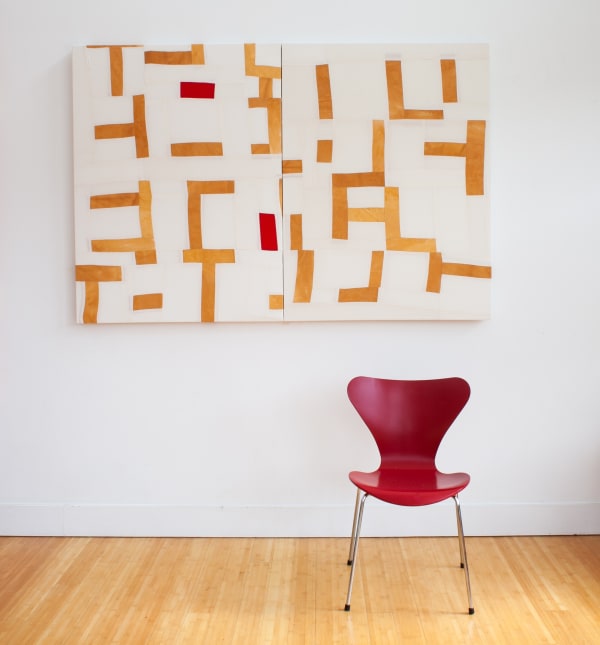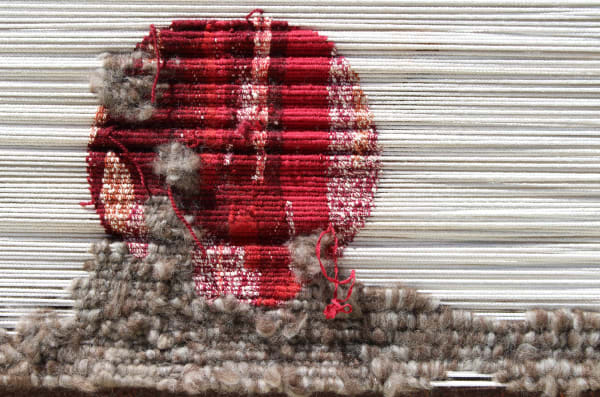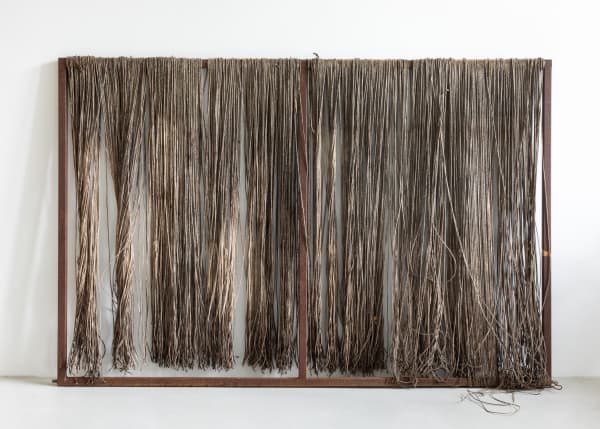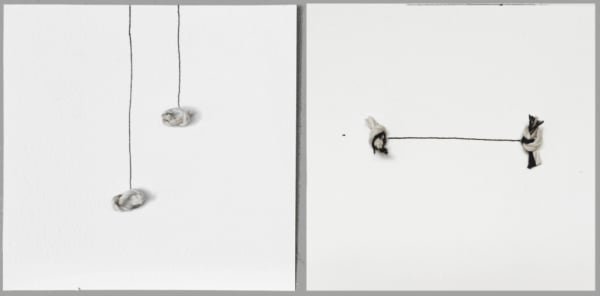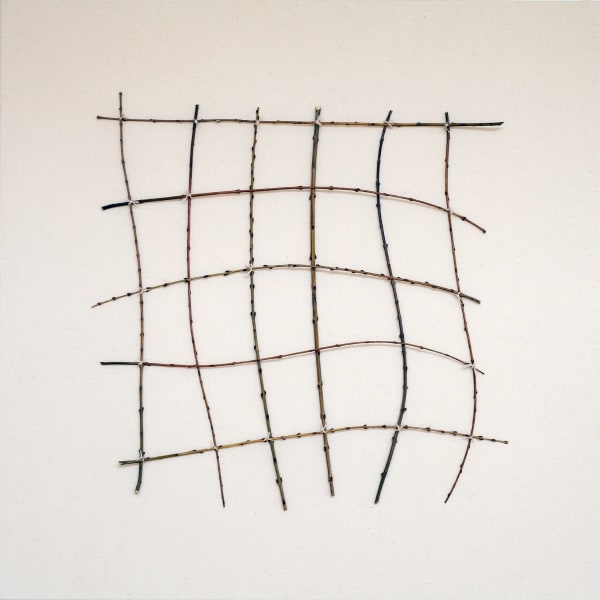In late 2019, a few months before the COVID-19 pandemic hit, Alice Hope, Bastienne Schmidt, and Toni Ross met to discuss an exhibition concept that would highlight the influence of archeology in their individual practices. As a prompt, they agreed to each select an artifact from the Metropolitan Museum of Art’s vast collection and respond to it. In a serendipitous event, and to their astonishment, each artist separately chose the Navigational Chart (Rebbilib) from the Marshall Islands.
Made from the stick-like midribs of coconut palm fronds and bound together with natural fiber strings to form a crisscrossed framework, navigational charts represent portions of the archipelago as they relate to different types of ocean currents and swell patterns. Before World War II and the advent of newer navigation technologies, Marshallese seamen utilized these maps as guides and mnemonic devices before crossing the Pacific Ocean in open canoes; each one was unique and fully decipherable only by its maker, serving also as a training aid to pass on navigation knowledge from one generation to the next.
The title No W here is a wordplay coined by Greg Dvorak in his book Coral and Concrete (2018). In this exhibition each artist responds independently to the aesthetic and cultural significance of the navigational chart, ruminating on how the simplicity of its formal properties belies its deep complexity of communication and wayfinding. Hope’s, Schmidt’s, and Ross’s lives and careers have overlapped for many years; over the past decade they have all had independent solo shows at Ricco/Maresca Gallery. For this project, to minimize their influence on each other, they confined themselves to their own studios—only sharing research and resources virtually.
No W here weaves the artists’ singular oeuvres into a cohesive visual narrative; the exhibition is one and indivisible, meant to be experienced in the simultaneity of three visions becoming one—literally and metaphorically. Inspired by the navigational chart, the resulting collective strives to create aesthetic experiences that facilitate recalibration and sense of place in this era of disequilibrium.
-
Economy of Place
—Alice HopeI was in the thick of learning about stick charts during the worst of COVID-19. Lockdown felt like a clipping of wings but coupled with navigation research kodachromed my world. My perception woke up to phenomena previously unnoticed. Space around me came symphonically dynamic and alive, and my studio generously opened, albeit virtually, to chart-centric conversations with anthropologists around the world. The navigation chart was my holy grail and my social network. It reminded me what I often forget: to be here.
Outside, a new alertness is in order, one that demands a deep connection to the position and movement of the body — or proprioception, sometimes referred to as the sixth sense.[1]
In line with my economy of means with materials, the pandemic has taught me economy of means of place. My work for No W here creates place and marks location in this period of time that we’re all living through together, while divided.K Corona and Proprioceptive 1 are single occupancy works. Our new choreographic rule, social distance, has necessitated a sharpened spatial awareness, a sixth sense I liken to Marshallese wave wayfinding.
The primary material for these installations is used Corona beer can tabs—the brand’s name a poetic coincidence with the virus. Months before the pandemic, I chose the tabs for their dual tone (gold and silver) which evokes preciousness and reflects light. As with the navigation chart, I was drawn to the tabs’ formalism, its economy of means and composition of positive and negative space, but the current cultural references magnify their relevance.
-
Breaking the Grid Open
—Bastienne SchmidtThe anchors have been lifted and we are navigating uncharted waters in new unfamiliar ways. I see the navigation chart from the Marshall Islands as a centering piece for all of us three artists—for what is at stake in this particular moment in time.
I have been working for the past five years with grids and mapping as conceptual spaces. We can go back to civilizations that did not mark territories and lived off the land grazing, not owning. Western culture is based on delimitation and land ownership. I think of spaces as ephemeral ideas, always subject to change.
My series Breaking the Grid Open developed out of the White Grids series, where I reflected upon the idea of white space sewn with raw canvas and minimalist interventions. I found numerous ways to divide it and explore solutions of abstract representation within a simple set of rules: the grid acts as a painter’s space in which only white and humble materials were to be used in geometric formations.
Drawing and sewing with strings creates a rhythm of shadow and light. The square grid in white is a quiet reflection on the concept of a centered, minimal space, and the idea of creating a series of never-ending variations is related to the search of Agnes Martin and Robert Ryman.
The sewn line creates a soft form of geometry, through the gentle pull of the fabric weave. There is always the idea typology at play, the principles of sameness and difference. Repetition of a gesture, of a mark, or a pattern are familiar practices to me. I grew up as the daughter of an archeologist in Greece, observing him organizing shards of Cypriot terracotta. I also developed, from my early upbringing in Germany, a love of geometric organization and the principles of Bauhaus.
In the works presented in No W here, I utilize fragile and recyclable materials such as fabric, pigment, branches, and threads to underline the ephemeralness of our life on earth and the frailty of our grids, which have now been broken by unprecedented events
The fabric of our individual and collective suffering has many different layers. A canoe, made of tracing paper and muslin fabric, outlined with threads and Nijiki twigs is a remnant of the concept of ancient Egyptians; the crossing of borders, from one world to the other. We don’t know if we will sink or swim, or where we will go, but we’re still looking for moments of unbridled joy.
-
Finding Time
—Toni RossThe steady advance of time and the visual concept of an aggregate form have been central in my creative life. During the pandemic, I felt I had lost all sense of time and space. The traditional markers of time disappeared, and I was, as so many of us were, untethered. A creative anchor emerged from the most nascent aspects of my practice: repetitive motion, remnants of form, the effect of time and weather on objects, the beauty of aged surfaces, and the juxtaposition of fragility and strength. As a way of navigating our heretofore unfamiliar waters, I began to explore the knot and twine fragments of reclaimed elements from Sanctuary Entwined, a 2017 monumental, site-responsive installation I created at East Hampton’s LongHouse Reserve. My explorations led to newly twined frames into which I began weaving aspects of the COVID-19 tracking patterns that emerged daily in the news.
Observing these patterns gave form to my sense of lost time, as what had at first been an unthinkable two weeks slowly morphed into many months, and now, more than a year.
The knots, coils, loose twine, and entire panels from Sanctuary Entwined provided raw material for discovery. Some of the twined segments function like root-systems, offering seedlings for creative regeneration. In assembling small knots of aged twine in linear patterns, I found them to evoke the rhythm of language. I also began to see the knots as markers from which a line drawn in ink creates an active tension, as if connecting to a time and place with relentless energy. In another work, a large mass of coiled hemp is gestural, possessed of action and resolution. Released from the structural tension it bore for over a year, the twine retains its own memory of being pulled taut and cinched around corners. And, now cut loose from their binding, the large skeins of twine that hang on original steel armatures create a new natural beauty while continuing to tell the story of their weathered past and, for me, pointing a way forward.
-
“Kwajalein is anything but the middle of nowhere...Kwajalein is, rather, the middle of both now and here, not nowhere but now-here.” – Greg Dvorak, Author of Coral and Concrete
The exhibition No W here opens June 3 and runs through September 11, 2021, at Ricco/Maresca Gallery in Chelsea. It is the grand debut for the collective of the same name, featuring artists Alice Hope, Toni Ross and Bastienne Schmidt. The artists share a deep friendship that has endured for more than 20 years and this is their first foray as a collective. The catalyst to their forming No W Here, and the resulting exhibition is based on a simple prompt that they agreed on; to select an artifact from the permanent collection of the Metropolitan Museum of Art and respond to it through their own artwork. Serendipitously, they each chose a Navigational Chart (Rebbilib) from the 19th-early 20th century. This map, and others like it, consists of delicately woven coconut palm fronds that form a grid of sorts. The sculptural object is minimal, and graphically simplistic. Its purpose was originally intended to instruct sailors of wave patterns and mark various locations of the Marshall Islands.
The selection of this particular object, fortuitous in nature, revealed an allegorical theme, previously unconscious, from which their new work is based: Navigation. Unexpectedly, COVID-19 ravaged much of the world. People retreated into their homes, stores shuttered their doors, restaurants closed, and for the first time in over a decade, planes weren’t crossing the sky as often. Hope, Ross, and Schmidt sought answers beyond isolation from the communal experience, and an unpredictable nature of the virus. A quote from Coral and Concrete, a book by Greg Dvorak published in 2018, in abbreviation, “...the middle of both now and here, not nowhere but now-here,” resonated with them as they individually and collectively embraced this new normal. Entering their respective studios, they each explored their personal relationship to way-finding, anthropology, maps and the revelation of plotting a course. The resulting work that they’ve produced is varied in aesthetics and technique. Yet, it overlaps through the rawness of material and a penchant for the nautical. The element of seeking, locating, and connecting is the metaphorical X marks the spot, the golden nugget that has tied them together and strengthened their already existing bond.
Alice Hope has made free-standing sculptures consisting of fishing lines, ball chains, and Corona beer can tabs. Organized in cylindrical and rectangular shapes, the work hangs from the ceiling of the gallery, and could almost be compared at first glance to a fishnet, constructed of materials meant to be recycled. The physicality of her sculpture can be encountered, walked through, and divide the gallery as a dimensional curtain of sorts. Toni Ross’ contribution includes a delicate, mixed media series of drawings on paper, as well as two hanging sculptural works made of string woven onto sturdy, repurposed wrought iron frames. One of her works in the show, actually graphs the movement of the Coronavirus as it spread in New York, California and Florida. In contrast to Hope’s sculptures, these are contained, yet seemingly unruly at their core, taut and loose simultaneously.. The artist whose work is most directly responsive to the Navigation Chart (Rebbilib), is Bastienne Schmidt. Grids have been part of her practice for quite some time, and the work in No W here follows a similar geometric pattern, not unlike the one found in the Navigation Chart. On untreated canvas, she uses wooden sticks curved into patterns, in some instances interacting with a stitched, layered tailored canvas and in yet another, pigmented and tinted muslin sewn together. Hers is a map in the closest sense of the word, reminiscent of Mondrian’s Broadway Boogie Woogie, stripped of color, and with less precise line structure. A commonality that they all share, is their collective desire to move through space, without the need to possess it. In each instance, the destination is here, the destination is now.
Rather than study wave patterns or chart directions to a particular land structure, No W here Collective have taken this opportunity to reference the exact moment we are all in. Looking forward, after experiencing the unprecedented, uncharted course that 2020 left in its wake, this exhibition relies on the power of art to locate. Art is a navigational compass, a destination without a shore. Conceptual at its core, a lighthouse at best, it has the power to remind someone of home, wherever that may be.
- Katy Hamer




